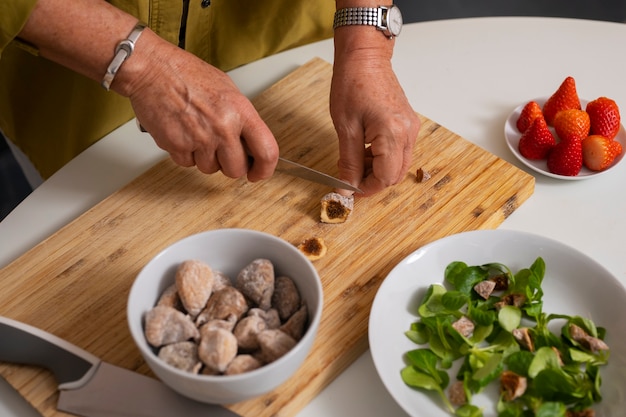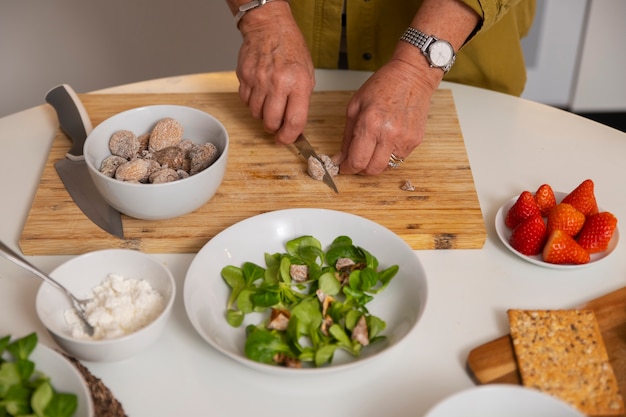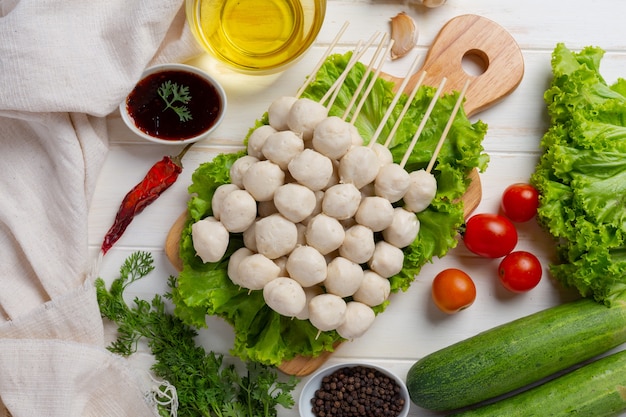Let's face it, there's something truly magical about meatballs. They're the quintessential comfort food, capable of transporting us back to childhood dinners, family gatherings, or even those lazy Sunday afternoons spent perfecting the art of the perfect sauce. As a seasoned cook, I've spent years exploring the world of meatballs, experimenting with countless recipes and techniques, and let me tell you, the journey has been absolutely delicious. So, grab your apron, gather your ingredients, and let's embark on a culinary adventure together!
(Part 1) The Meat: Your Foundation of Flavour

Think of your meat as the canvas for your masterpiece. You wouldn't start a painting on a cracked and faded canvas, would you? The same goes for meatballs. Choose high-quality, fresh meat, and you'll be rewarded with a meatball that sings with flavour. For classic beef meatballs, I find a good 80/20 blend of chuck and sirloin strikes the perfect balance. You get that juicy, rich flavour from the fat, but the leaner cut ensures your meatballs aren't swimming in grease.
Choosing the Right Meat
Don't be afraid to branch out beyond beef! There's a whole world of meatball possibilities waiting to be explored. Here are a few suggestions to get you started:
- Beef: The classic, the reliable, the all-around crowd-pleaser. I love using a blend of chuck and sirloin because it gives me that beautiful balance of fat and lean. But if you're feeling adventurous, try using ground short rib for an incredibly rich and flavourful meatball.
- Pork: This adds a lovely sweetness and richness that complements beef beautifully. Look for a ground pork blend with a higher fat content for the most tender and juicy results. You can even add a touch of ground pancetta for an extra layer of flavour.
- Lamb: This is a bold choice, bursting with a distinct earthy flavour. Ground lamb with a higher fat content will give you a more succulent meatball. Consider pairing it with a tangy lemon and herb sauce for a truly delicious combination.
- Chicken or Turkey: If you're looking for a lighter, leaner option, ground chicken or turkey is a great choice. They can also be mixed with other meats, like beef or pork, for added flavour and moisture. Think of them as your blank canvas, ready to be transformed with your favourite spices and sauces.
(Part 2) Mastering the Mix: The Art of the Blend

Now, this is where the real magic happens. You've got your meat, but now you need to create a symphony of flavour and texture. The meat is just the beginning; it's the mix that truly elevates your meatballs to the next level. And here's the secret: it's not just about the ingredients, it's about how you bring them together.
The Essential Ingredients:
These are the core players in your meatball mix, the ones that contribute to that classic meatball texture and hold everything together. But remember, there's plenty of room for personalization, so don't be afraid to get creative!
- Breadcrumbs: The unsung heroes of the meatball mix, they're not just for texture; they actually absorb moisture, keeping your meatballs juicy and tender. I prefer to use fresh breadcrumbs, made from crusty bread, but you can also use store-bought breadcrumbs. Just be sure to avoid the finely-ground kind, as they can make your meatballs dense.
- Eggs: They act as a binder, holding everything together and adding a touch of richness to the flavour. One or two eggs are usually enough for a standard batch of meatballs, but you can adjust depending on the amount of meat you're using.
- Milk or Water: This helps to create a moist and tender meatball. A little bit goes a long way, and you can use either milk or water. I often use a combination of both, finding that it results in a beautifully balanced texture.
- Seasonings: Now, this is where the fun really begins! Salt, pepper, garlic, and onion are the basic building blocks, but don't be afraid to experiment with herbs, spices, and even a dash of chilli for a kick. Think of your favourite flavours and see how they translate into a delicious meatball.
The Mixing Technique:
It's a delicate dance, my friends. Too much mixing and your meatballs will be tough and dry. The goal is to combine the ingredients until they are just mixed, ensuring everything is evenly distributed. Use a light touch and avoid overworking the mixture. Remember, gentle hands are the key to tender, delicious meatballs.
(Part 3) Shaping Your Meatballs: The Perfect Form

Alright, now we're getting into the creative part! Do you prefer perfectly round, classic meatballs, or maybe something more rustic and free-form? It's all about personal preference, but no matter your chosen shape, remember to handle the meatball mix with care. Overly aggressive shaping can lead to dense, tough meatballs, and we want them to be light and fluffy, right?
Tips for Shaping:
- Wet your hands: This simple trick will prevent the meatball mix from sticking to your hands, making the shaping process much smoother. Just a quick rinse under cold water will do the trick.
- Use a spoon: Scoop out a portion of the meatball mix and gently roll it into a ball using the back of a spoon. It's a classic technique that works wonders, especially for those who aren't comfortable with their hands.
- Use a meatball scoop: For perfectly sized and consistent meatballs, a dedicated meatball scoop is a lifesaver. They come in various sizes, so choose one that fits your desired meatball size.
- Don't overwork: Gently form the meatballs, avoiding excessive squeezing or manipulation. Remember, the goal is to create a light and airy texture, not a dense, compact ball.
(Part 4) The Perfect Cooking Method: A Symphony of Heat
We're getting close to the grand finale! Now it's time to bring your meatballs to life. The cooking method you choose will have a huge impact on the final result, so choose wisely. Pan-frying, oven baking, or simmering in a sauce - each method delivers a distinct texture and flavour.
Pan-Frying:
For a crispy exterior and a juicy, tender interior, pan-frying is the way to go. Use a heavy-bottomed pan, as this will distribute heat evenly and prevent hot spots. Heat the pan over medium heat, add a tablespoon of oil (I prefer olive oil), and then carefully place your meatballs in the pan, making sure they have enough space to brown evenly. Cook for about 5-7 minutes, turning them occasionally to achieve a beautiful golden-brown crust on all sides.
Oven Baking:
If you're looking for a hands-off approach, oven baking is the perfect solution. Preheat your oven to 350 degrees fahrenheit (175 degrees Celsius). Line a baking sheet with parchment paper (this will prevent sticking and make cleanup a breeze) and then arrange your meatballs in a single layer, ensuring they have enough space for air circulation. Bake for 20-25 minutes, or until cooked through. You'll know they're done when they're firm to the touch and the internal temperature reaches 160 degrees Fahrenheit (71 degrees Celsius).
Simmering in Sauce:
Ah, the ultimate comfort food experience! Simmering your meatballs in a rich and flavourful sauce is a classic for a reason. It infuses the meatballs with the sauce's essence, creating a delicious symphony of flavour. Whether you prefer a classic marinara, a creamy Alfredo, or a spicy arrabiata, there's a sauce out there for every taste. For the best results, gently brown your meatballs in a pan first, then transfer them to your sauce and simmer until they're cooked through and the sauce has thickened.
(Part 5) Saucing Up Your Meatballs: The Finishing Touch
The sauce is the final flourish, the element that elevates your meatballs from good to truly great. It enhances the flavour, adds a touch of sweetness, and creates a luxuriously satisfying experience for your taste buds.
Classic Tomato Sauce:
A timeless favourite, a classic tomato sauce is the perfect companion for meatballs. Made with crushed tomatoes, onions, garlic, herbs, and a touch of sweetness, it creates a harmonious blend of tangy, sweet, and savoury notes. The key is to simmer the sauce gently for at least 30 minutes to allow the flavours to meld and deepen.
creamy alfredo sauce:
For a richer and more decadent experience, try a creamy Alfredo sauce. Made with butter, heavy cream, Parmesan cheese, and a touch of garlic, it creates a velvety smooth sauce that coats your meatballs with a luxurious finish. Be sure to use high-quality Parmesan cheese for the best flavour.
Spicy Arrabiata Sauce:
If you like things hot, a spicy arrabiata sauce is for you. Made with crushed tomatoes, chilli flakes, garlic, and herbs, it delivers a fiery kick that will leave you wanting more. The amount of chilli flakes you use is entirely up to you, so start with a small amount and adjust according to your taste.
Sweet and Sour Sauce:
For a fun and flavourful twist, try a sweet and sour sauce. This classic Chinese sauce is a delightful contrast to the savoury meatballs. It's typically made with a combination of vinegar, sugar, soy sauce, and ginger. You can also add a touch of pineapple or orange juice for an extra layer of sweetness.
(Part 6) Serving Up Your meatball masterpieces: The Presentation
You've poured your heart and soul into making these delicious meatballs, now it's time to present them in a way that's as appealing as they are flavourful.
Classic Italian Style:
Serve your meatballs over a bed of spaghetti or linguine, topped with your favourite tomato sauce and a sprinkle of grated Parmesan cheese. Add a fresh basil leaf for a touch of elegance and a pop of colour.
Swedish Meatballs:
For a unique twist, serve your meatballs with a creamy gravy, mashed potatoes, and lingonberry sauce. This classic Swedish dish is a crowd-pleaser and a true taste of Scandinavia.
Mini Meatballs:
For a party or a more casual gathering, serve your meatballs as appetizers. Skewer them with toothpicks and offer a variety of sauces for dipping. A classic marinara, a creamy pesto, or a tangy balsamic glaze would all be delicious choices.
Meatball Subs:
For a hearty and satisfying meal, pile your meatballs onto toasted hoagie rolls, top them with your favourite sauce, and add a sprinkle of mozzarella cheese. It's a simple yet satisfying way to enjoy your delicious meatballs.
(Part 7) meatball variations: Exploring the World of Flavour
Now that you've mastered the basics, it's time to venture into the exciting world of meatball variations. The possibilities are endless! Experiment with different meats, seasonings, sauces, and ingredients to create your own unique creations.
italian meatballs with Herbs:
Add a blend of fresh herbs like basil, oregano, and parsley to your meatball mixture for an authentic Italian flavour. A pinch of dried red pepper flakes will add a touch of warmth and complexity.
Spicy Asian Meatballs:
Embrace the bold flavours of Asia by adding ginger, garlic, chillies, and soy sauce to your meatball mix. Serve with a sweet and spicy sauce for a truly authentic experience.
Greek Lemon and Herb Meatballs:
For a fresh and tangy twist, add lemon zest, lemon juice, and fresh herbs like dill, mint, and parsley to your meatball mix. Serve with a side of orzo pasta tossed with olive oil and lemon juice for a complete and flavourful meal.
Tex-Mex Meatballs:
Spice things up with a Tex-Mex twist! Add cumin, chili powder, paprika, and a touch of cayenne pepper to your meatball mix. Serve them with a spicy salsa, guacamole, and sour cream for a flavourful fiesta in your mouth.
(Part 8) Meatballs for Everyone: Adapting to Dietary Needs
Whether you're a vegetarian, vegan, or simply looking for a healthier alternative, there are plenty of ways to enjoy the deliciousness of meatballs without compromising your dietary needs.
vegetarian meatballs:
Replace the meat with a blend of lentils, quinoa, breadcrumbs, vegetables, and spices. You can also use a vegetarian ground meat substitute, which are readily available in most supermarkets. Experiment with different vegetable combinations, like finely diced carrots, zucchini, and mushrooms, to add texture and flavour.
Vegan Meatballs:
Use a blend of vegetables, nuts, seeds, and breadcrumbs to create a flavorful and meat-free alternative. Walnuts, cashews, and sunflower seeds add a lovely nutty flavour, while breadcrumbs and oats provide structure. Be sure to use a plant-based milk, like almond milk or soy milk, in your mix.
Gluten-Free Meatballs:
Use gluten-free breadcrumbs or almond flour as a binder in your meatball mixture. Both options are readily available in most grocery stores. If you're using almond flour, be sure to add a bit more liquid to your mix, as it absorbs moisture more quickly than traditional breadcrumbs.
(Part 9) FAQs: Your Meatball Queries Answered
Let's face it, we all have those lingering questions, those doubts that keep us from achieving meatball perfection. Well, fret no more! Here are answers to some of the most frequently asked questions about meatballs:
1. How do I know when my meatballs are cooked through?
The best way to ensure your meatballs are cooked through is to use a meat thermometer. Insert it into the centre of a meatball and ensure it reaches an internal temperature of 160 degrees Fahrenheit (71 degrees Celsius). This is the safe temperature for both meat and poultry.
2. Can I freeze meatballs?
Absolutely! Freezing meatballs is a great way to have a delicious and convenient meal ready in a flash. Simply place the cooked meatballs in a freezer-safe container or bag, and freeze for up to 3 months. To reheat, thaw the meatballs in the refrigerator overnight, then reheat them in the oven, microwave, or on the stovetop.
3. What are the best sauces for meatballs?
The best sauce for meatballs is a matter of personal preference. However, some popular choices include classic tomato sauce, creamy Alfredo sauce, spicy arrabiata sauce, sweet and sour sauce, and pesto. Don't be afraid to get creative and try new combinations!
4. How long should I cook meatballs in the oven?
The cooking time for meatballs in the oven will vary depending on the size and number of meatballs. As a general rule, bake meatballs at 350 degrees Fahrenheit (175 degrees Celsius) for 20-25 minutes, or until cooked through. You can also check for doneness by gently pressing on the meatballs. They should be firm to the touch and no longer pink in the centre.
5. What can I do with leftover meatballs?
There are plenty of things you can do with leftover meatballs! You can use them in sandwiches, salads, pasta dishes, or even as a topping for pizza. You can also add them to a soup or stew for a hearty and flavourful meal.
(Part 10) The Meatball Journey: A Continuous Exploration
Making meatballs is a journey, a continuous exploration of flavour, technique, and creativity. There's always something new to discover, a new ingredient to try, a new sauce to experiment with. So, embrace the journey, have fun, and most importantly, enjoy the delicious results of your labour.
Remember, the best meatball recipe is the one that you create. Don't be afraid to experiment, to add your personal touch, and to create your own meatball masterpiece. After all, that's what makes cooking so much fun, isn't it? Happy meatball making!
Everyone is watching

How to Cook Frozen Lobster Tails Perfectly: A Step-by-Step Guide
RecipesLobster. Just the word conjures up images of lavish meals, special occasions, and a taste of luxury. But let's...

Pigs in a Blanket Cooking Time: How Long to Bake for Perfect Results
RecipesAh, pigs in a blanket. Just the name conjures up images of those delightful little parcels of crispy pastry en...

Pork Fillet Cooking Time: How Long to Cook It Perfectly
RecipesPork fillet, or tenderloin as it's sometimes called, is a real favourite in our house. It's so versatile, and...

The Ultimate Guide to Cooking Delicious Frankfurters
RecipesLet's face it, we all love a good frankfurter. It's a classic, simple, and always satisfying. But let's be rea...

Wolf Meat Recipes: A Guide to Cooking Wild Game
RecipesLet's be honest, you don't see wolf meat at your local butcher shop every day. It's a bit of a wild card, but ...
